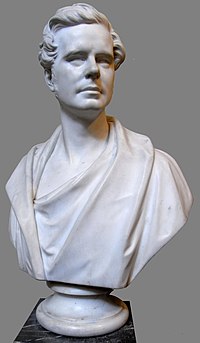William Webb Follett
Sir William Webb Follett (2 December 1796 – 28 June 1845) was an English lawyer and politician who served as MP for Exeter (1835–1845). He served twice as Solicitor-General, in 1834-5 and 1841 and as Attorney-General in 1844. He was knighted in 1835. He was reputed to have been the "greatest advocate of the century".[1]



Origins
Follett was born at Topsham in Devon, the eldest son (of ten children) of Captain Benjamin Follett, late 13th Regiment of Infantry, who had retired from the army in 1790 and gone into business as a timber merchant,[2] and his wife Ann Webb, daughter of John Webb, of Kinsale, Ireland.[3][4] His younger brother was Brent Spencer Follett (1810–1887) QC, MP.[4]
Career
Follett received his education at Exeter grammar school and Trinity College, Cambridge, graduating in 1818.[5] Follett entered the Inner Temple in 1816 and began to practise as a pleader below the bar in 1821, was called to the bar in 1824, and joined the western circuit in 1825. In 1835 he was returned to parliament for Exeter. In parliament he rapidly distinguished himself, and under the first administration of Sir Robert Peel he was appointed in November 1834 as Solicitor-General. He resigned with the ministry in April 1835. In the course of this year he was knighted. On the return of Peel to power in 1841 Follett was again appointed Solicitor-General, and in April 1844 he succeeded Sir Frederick Pollock as Attorney-General.[6]
Marriage
In 1830 Follett married the eldest daughter of Sir Ambrose Hardinge Giffard (1771–1827) chief justice of British Ceylon.
Death and burial
His health began to fail him in 1838, and he was permanently injured by a severe illness in 1841. In 1845 his health broke down, and he was compelled to relinquish legal practice and to visit the south of Europe to recuperate. He returned to England in March 1845, but the tuberculosis, with which he had previously been diagnosed, reasserted itself and he died in London on 28 June 1845.[6] He was buried in the Temple Church in London.[1]
Monuments
A statue of Follett executed by William Behnes was erected by subscription in Westminster Abbey.[6] His marble bust by Edward Bowring Stephens exists in the Devon and Exeter Institution, Exeter.
References
- Per inscribed plaque on base of his bust in the Devon & Exeter Institution
- The Heraldic Register 1849-1850, with an annotated obituary, Bernard Burke, E. Churton, 1850, p. 73
- Ryall's Portraits of Conservative Statesmen, Henry Thomas Ryall, p. 1
- Dod, Charles Roger Phipps (1852). The Parliamentarian Companion (2nd ed.). London: Whitaker and Co. p. 178.
- "Follett, William Webb (FLT813WW)". A Cambridge Alumni Database. University of Cambridge.
-
 One or more of the preceding sentences incorporates text from a publication now in the public domain: Chisholm, Hugh, ed. (1911). "Follett, Sir William Webb". Encyclopædia Britannica. 10 (11th ed.). Cambridge University Press. p. 602.
One or more of the preceding sentences incorporates text from a publication now in the public domain: Chisholm, Hugh, ed. (1911). "Follett, Sir William Webb". Encyclopædia Britannica. 10 (11th ed.). Cambridge University Press. p. 602.
External links
- Hansard 1803–2005: contributions in Parliament by Sir William Webb Follett
| Parliament of the United Kingdom | ||
|---|---|---|
| Preceded by James Wentworth Buller Edward Divett |
Member of Parliament for Exeter 1835 – 1845 With: Edward Divett |
Succeeded by Sir John Duckworth, Bt Edward Divett |
| Political offices | ||
| Preceded by Sir Robert Rolfe |
Solicitor-General for England and Wales 1834–1835 |
Succeeded by Sir Robert Rolfe |
| Preceded by Sir Thomas Wilde |
Solicitor-General for England and Wales 1841–1844 |
Succeeded by Sir Frederic Thesiger |
| Preceded by Sir Frederick Pollock |
Attorney-General for England and Wales 1844–1845 |
Succeeded by Sir Frederic Thesiger |